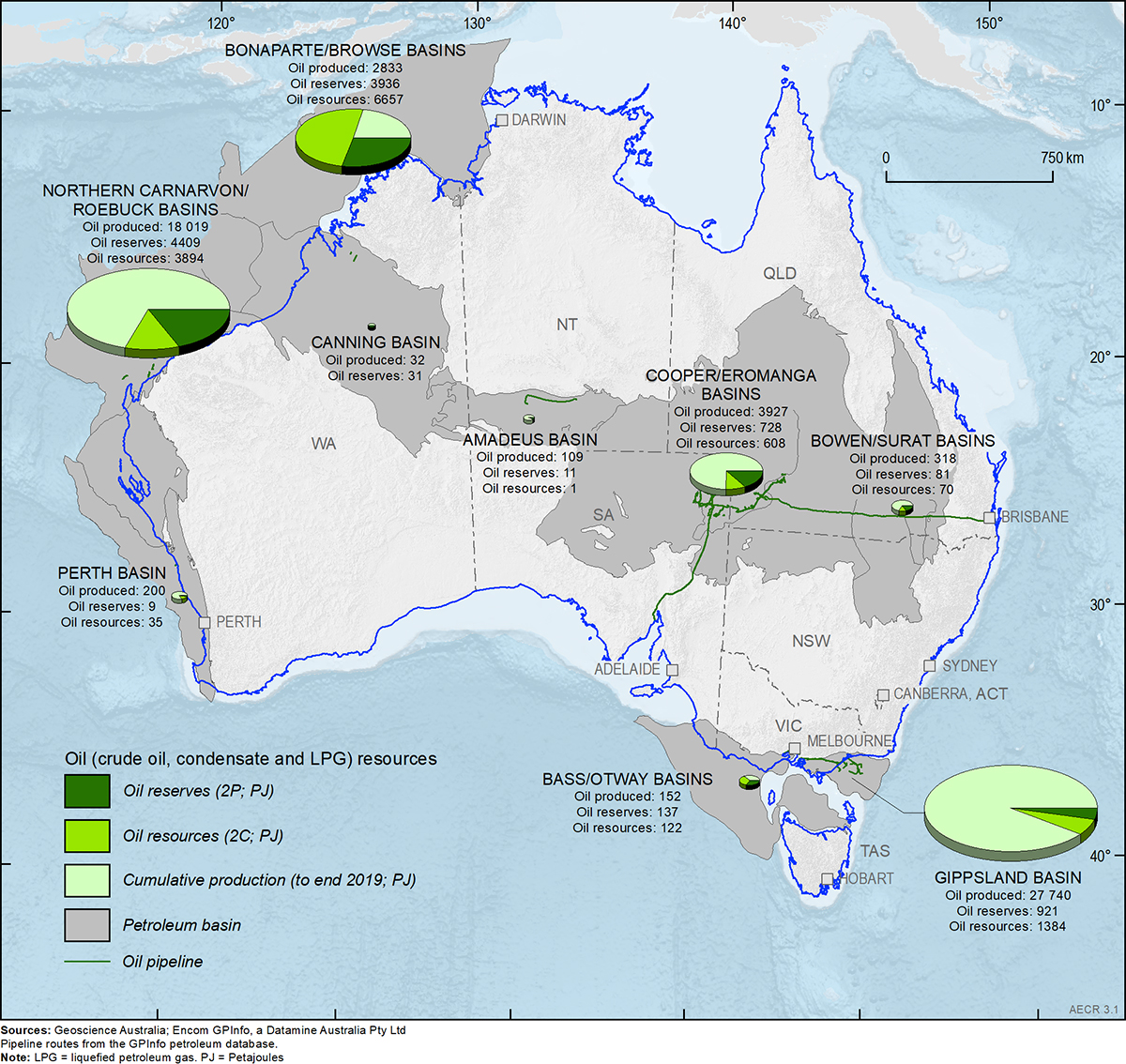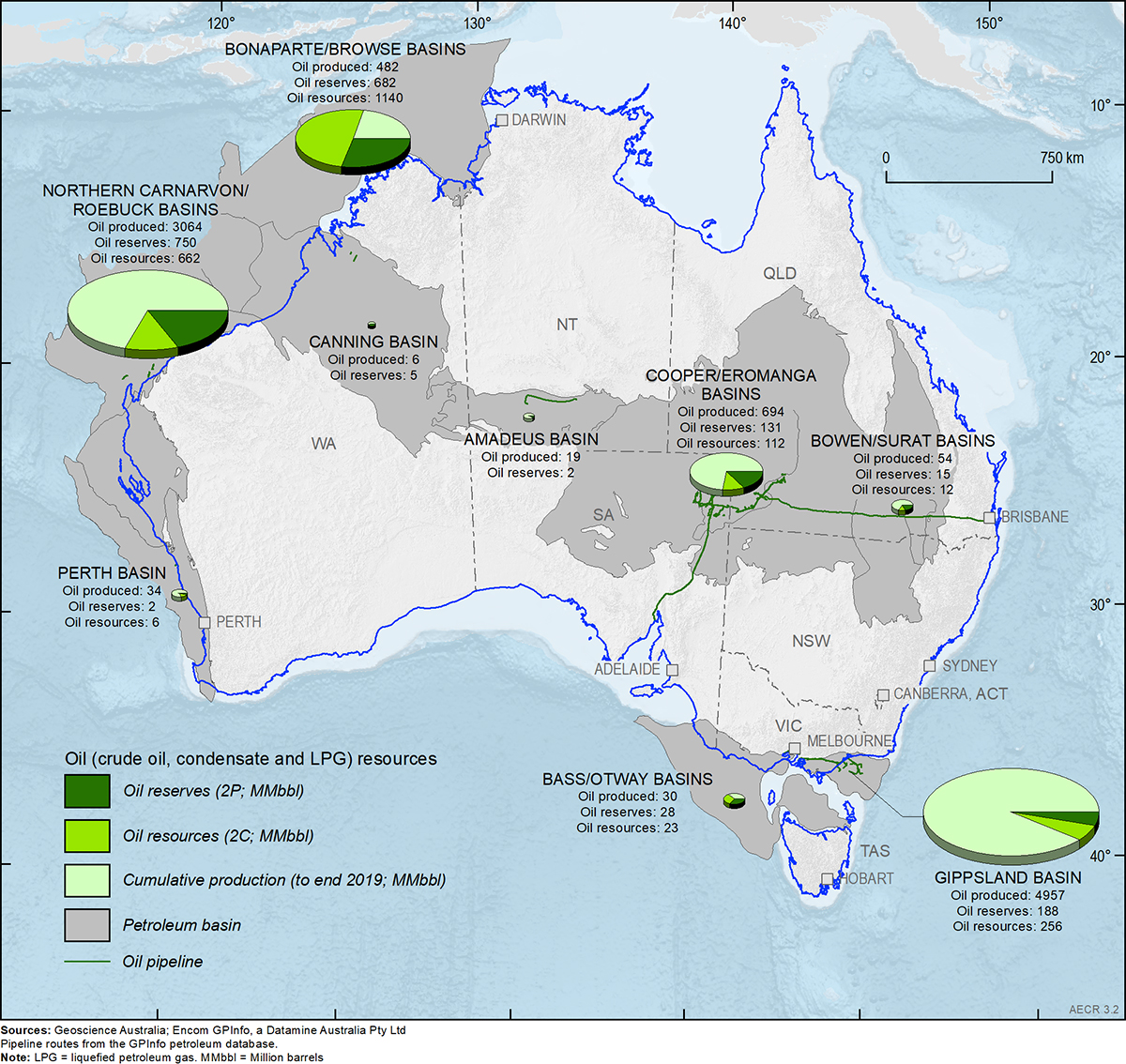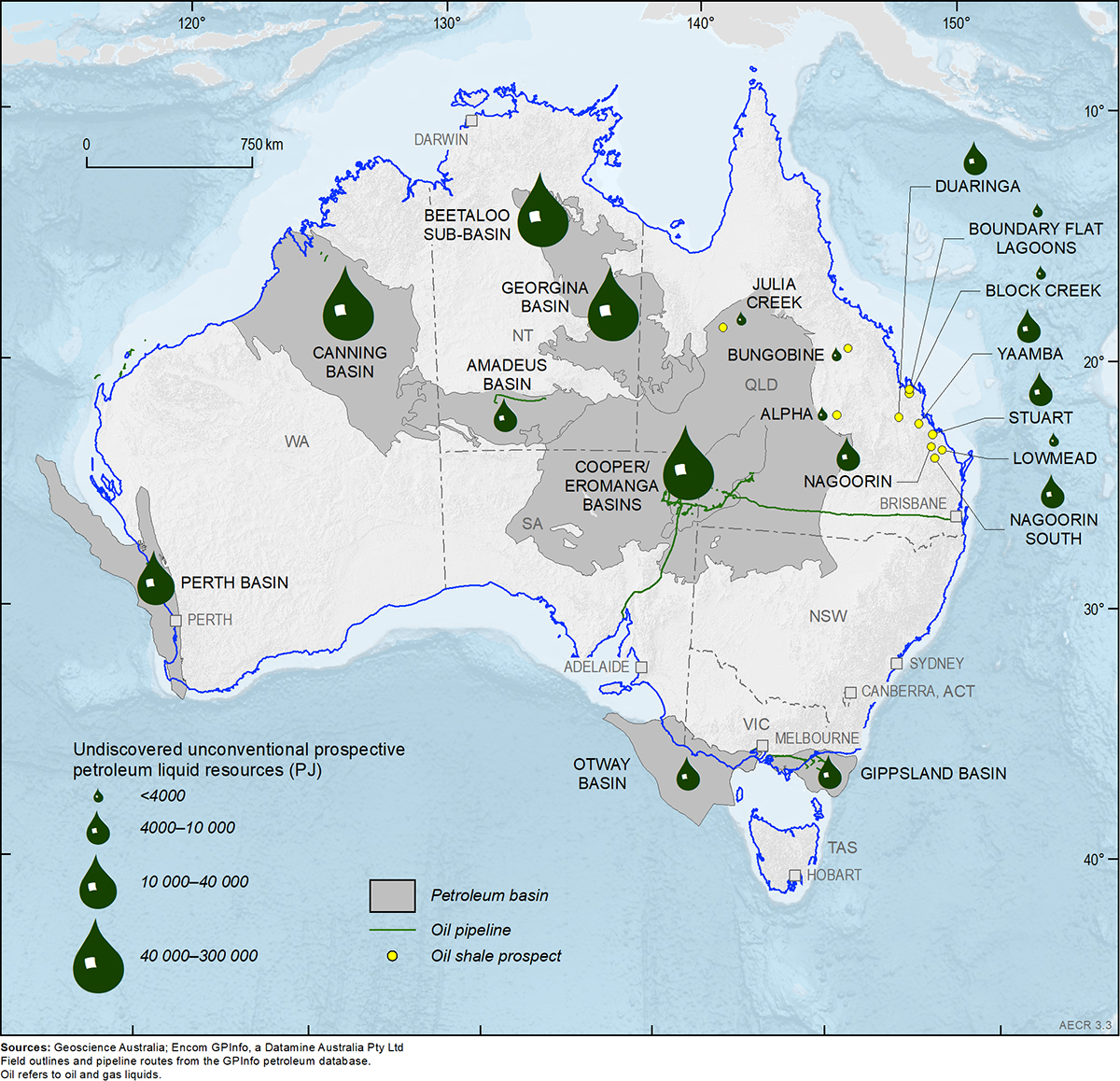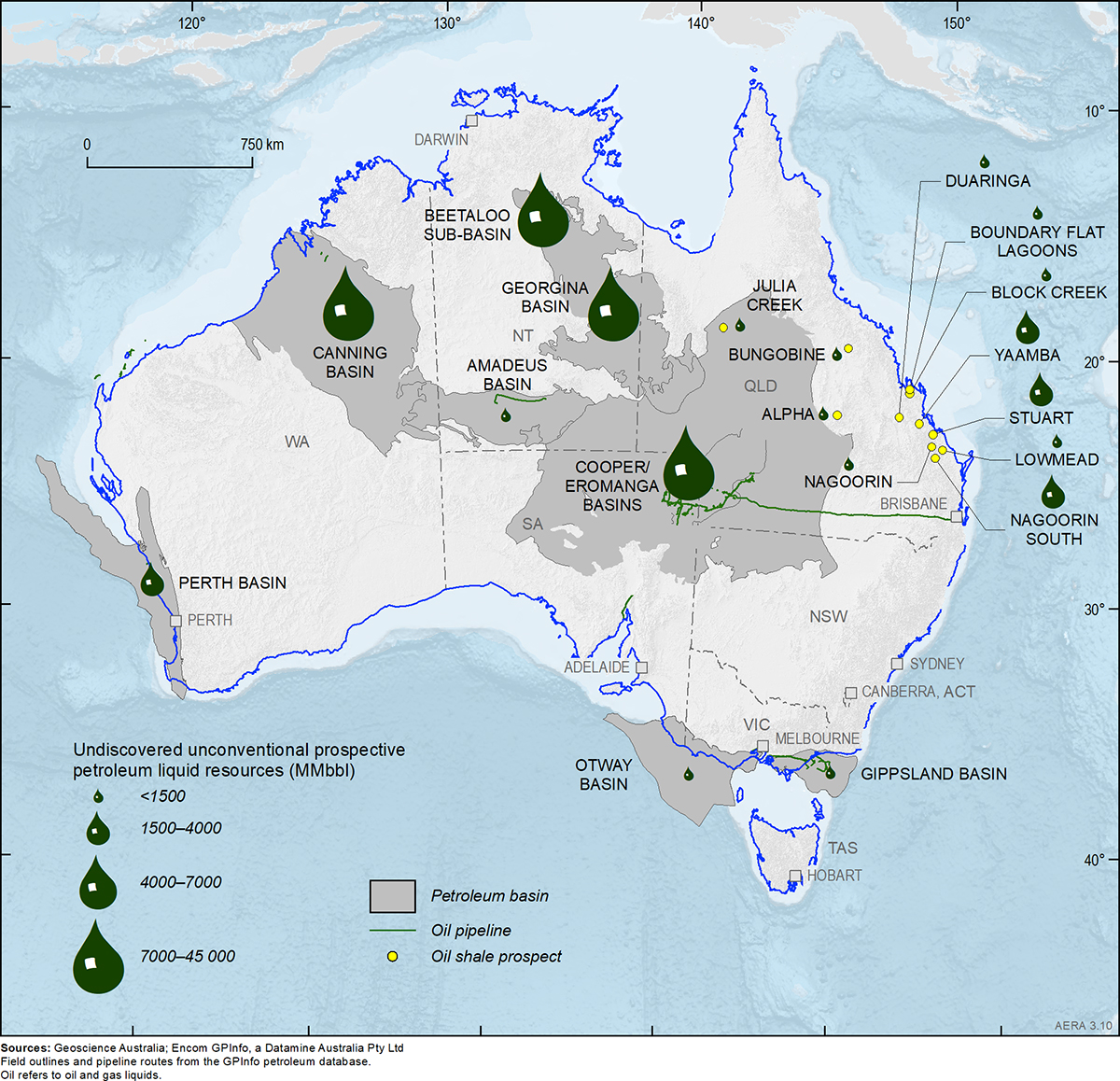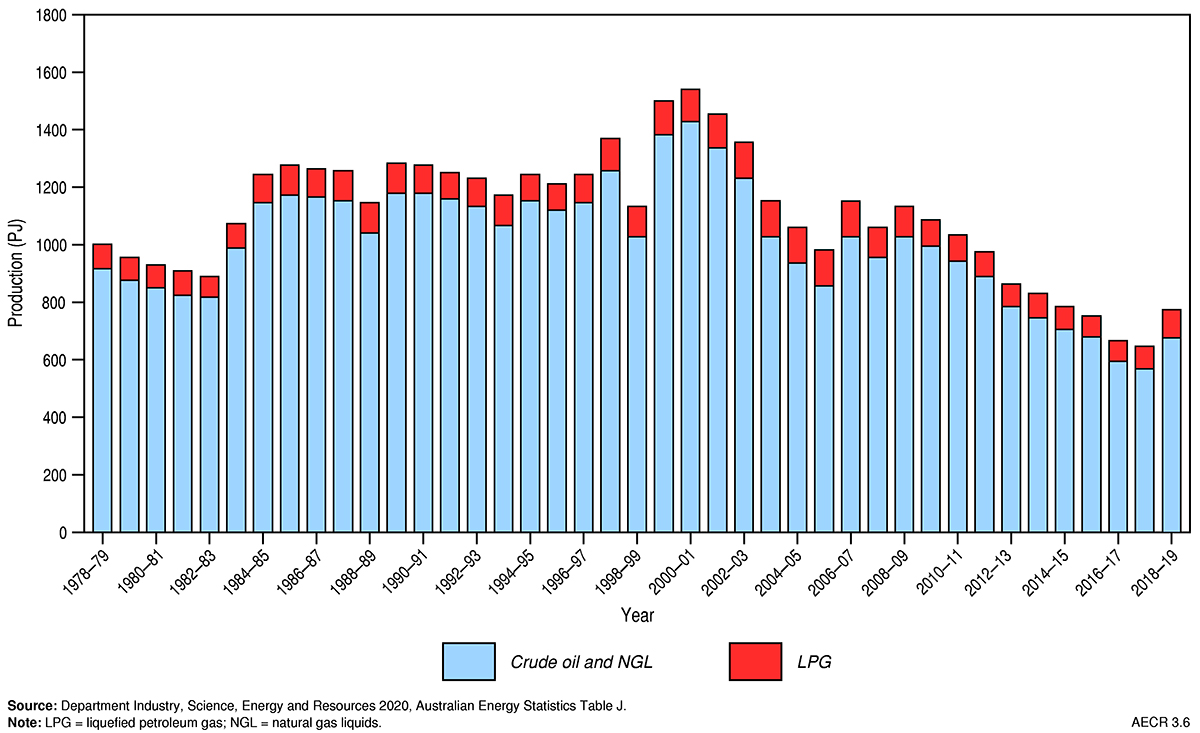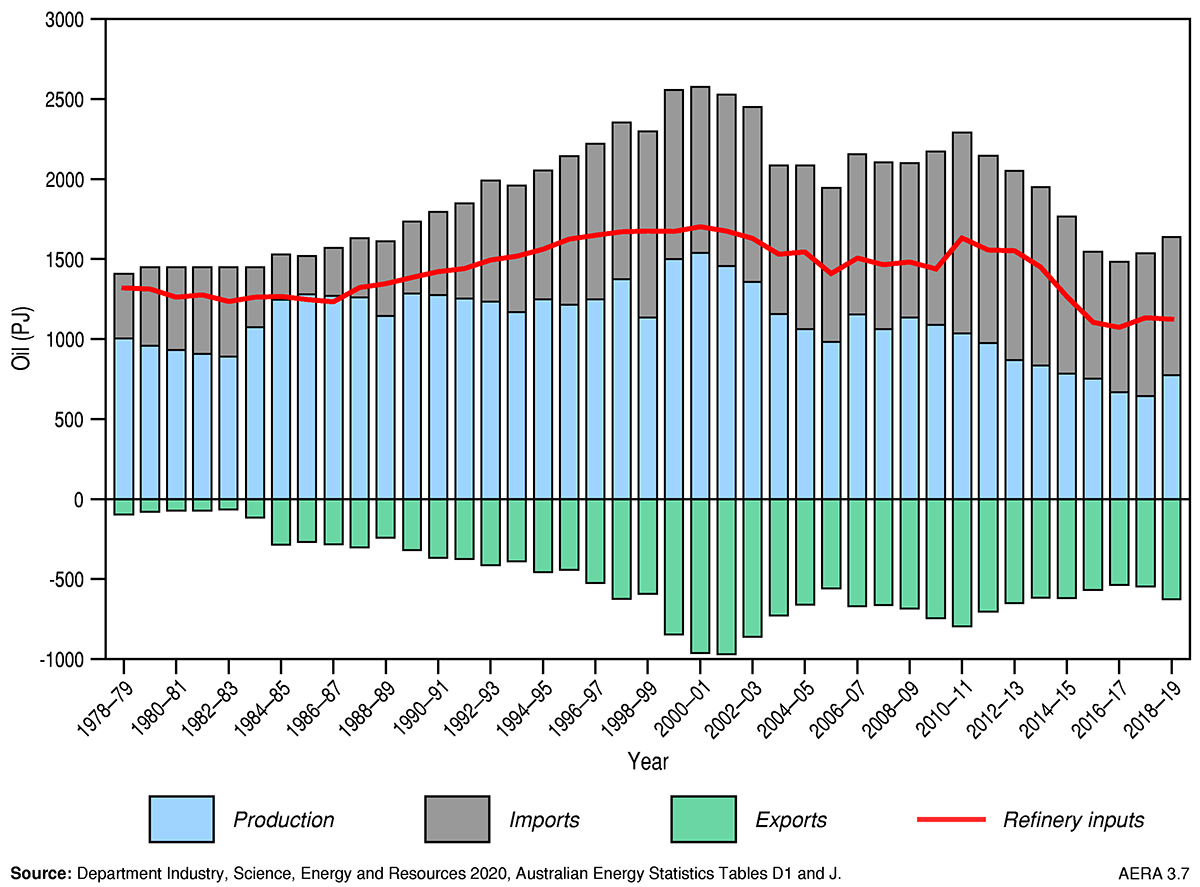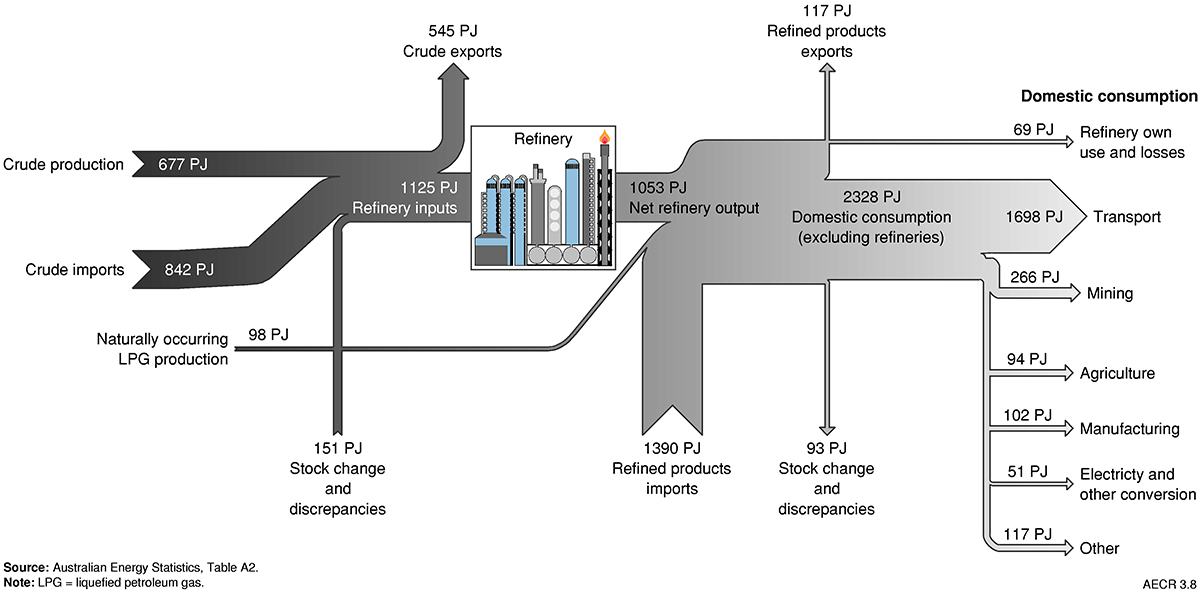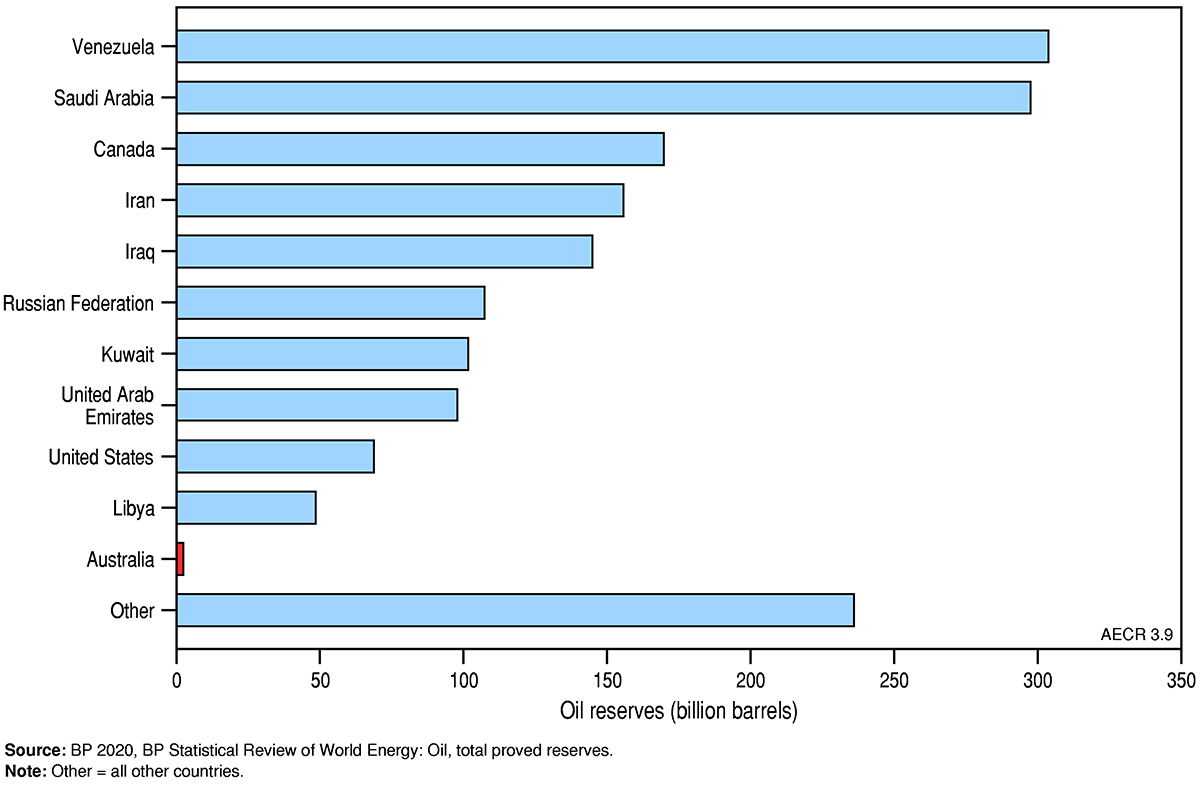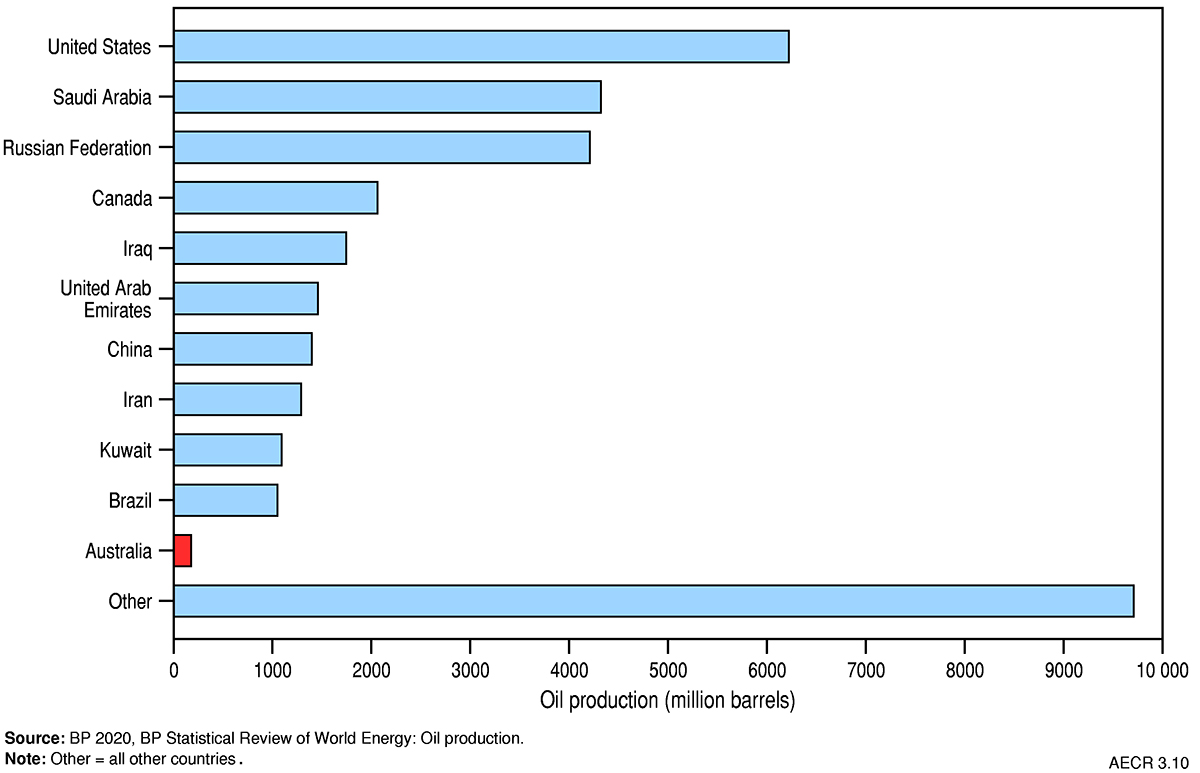Key messages
- Oil is a liquid that forms when accumulations of organic matter are buried and exposed to increasing heat and pressure over geological time.
- Australia has limited identified conventional oil resources and large undiscovered prospective unconventional oil resources.
- Australian oil production has been in decline since 2009 as new reserve developments have failed to match the rate of depletion in existing fields. Oil production in 2019 showed a reversal to this long-term trend following the start-up of the Greater Enfield, Ichthys and Prelude projects on the North West Shelf.
- Australia is a net importer of oil and imports a large proportion of its refinery feedstocks. Most of Australia’s oil is produced on the North West Shelf, some distance from domestic east coast refining capacity. In addition, domestically produced grades of crude oil are generally not suited for local refineries compared to other internationally sourced oil.
Summary
Australia is a net importer of oil, with only around 12 per cent of refinery feedstock domestically produced. ‘Oil’ in this report refers to any hydrocarbon liquids, including conventional crude oil, condensate and liquefied petroleum gas (LPG); and unconventional shale oil, oil shales, basin centred oil, coal oil and tight oil.
Oil resources are reported using the SPE-Petroleum Resources Management System. Reserves are commercially recoverable amounts of petroleum that remain in known accumulations, of which 2P reserves are the best estimate (the sum of Proved plus Probable Reserves). Australia’s 2P reserves of conventional oil resources in 2019 are estimated as 10,263 petajoules (PJ; 1,803 million barrels [MMbbl]). At 2019 production rates, this is the equivalent of about 14 years of remaining conventional oil reserves. About 80 per cent of Australia’s produced oil was exported in 2019.
Contingent resources are potentially recoverable amounts of petroleum in known accumulations, of which 2C contingent resources are the best estimate. Contingent resources are not yet considered to be commercially recoverable due to one or more technical, commercial or other factors. Australia’s 2C contingent resources of conventional oil in 2019 are estimated as 12,771 PJ (2,210 MMbbl).
About three quarters of all oil production in 2019 came from fields in offshore north-western Australia. This included condensate resources produced from a few supergiant and giant gas fields in the offshore Northern Carnarvon Basin and the neighbouring Browse Basin. The remaining oil volumes were produced from fields within the Gippsland and the Cooper basins in south-eastern Australia.
Australia has significant undiscovered unconventional oil resources potential, including shale oil, tight oil, basin centred oil and oil shale. Oil shale is the only unconventional oil resource that has been exploited to date. Currently, there is no commercial production of oil shale resources in Australia.
Australia's identified oil resources
Identified resources are those that have been discovered and their locations, quantity and quality are known from measurements or direct geological evidence. Identified oil resources, for the purposes of this report, are the equivalent of discovered 2P reserves and 2C contingent resources in the SPE-Petroleum Resources Management System.
The 2019 resource estimates compiled for this report are based on publicly available data for onshore areas aggregated with confidential offshore data submitted to the National Offshore Petroleum Titles Administrator (NOPTA). Offshore data are reported for calendar year 2019, while onshore data are based on government statistics and company estimates reported at various dates between June 2019 and June 2020. Data are aggregated for composite basin regions where necessary to de-identify confidential offshore field data in the custody of NOPTA.
Most remaining identified offshore oil resources occur in basins from either north‑west or south‑east Australia. Onshore, the Cooper–Eromanga basin in South Australia and Queensland holds the greatest quantity of identified remaining conventional oil resources (Figure 1 and Figure 2; Table 1 and Table 2).
Crude oil
Australia has limited domestic supplies of crude oil, with estimated remaining 2P reserves of 2,086 PJ (355 MMbbl), and 3,576 PJ (608 MMbbl) of 2C contingent resources in 2019 (Table 1; Table 2; Figure 1 and Figure 2). Aggregating Australia’s 2P reserves and 2C contingent resources gives a total of 5,661 PJ (963 MMbbl) of identified crude oil resources. Over half of Australia’s remaining identified crude oil resources are located in the Northern Carnarvon and Roebuck basins. About one quarter of Australia’s crude oil reserves are located in the Cooper Basin, while approximately one quarter of remaining contingent resources are located in the Gippsland Basin. Based on 2019 production rates of 261 PJ (44 MMbbl), Australia’s identified crude oil resources would have a life of 22 years if all identified contingencies to development are mitigated.
Condensate
Australia has significant remaining condensate resources, including 7,321 PJ (1,245 MMbbl) of 2P reserves and 8,630 PJ (1,468 MMbbl) of 2C contingent resources in 2019 (Table 1; Table 2; Figure 1 and Figure 2). Aggregating Australia’s 2P reserves and 2C contingent resources gives a total of 15,951 PJ (2,713 MMbbl) of identified condensate resources. The majority of identified condensate resources are located in supergiant and giant gas fields along the North West Shelf. Based on 2019 production rates of 450 PJ (76 MMbbl), Australia’s identified condensate resources would have a life of 35 years if all identified contingencies to development are mitigated.
LPG
Australia’s LPG resources in 2019 are estimated as including 856 PJ (203 MMbbl) of 2P reserves and 565 PJ (134 MMbbl) of 2C contingent resources. However, those estimates do not include any identified LPG resources for the Northern Carnarvon Basin due to the lack of reported LPG reserves or contingent resources for this basin area in the offshore data. As there are significant volumes of LPG produced from the North West Shelf project in the Northern Carnarvon Basin, the LPG estimates are less than actual LPG reserves and contingent resources. Aggregating Australia’s 2P reserves and 2C contingent resources gives a total of 1,421 PJ (338 MMbbl) of identified LPG resources. Based on 2019 production rates of 44 PJ (10 MMbbl), Australia’s identified LPG resources would have a life of 32 years if all identified contingencies to development are mitigated.
Unconventional petroleum
Australia has significant potential for unconventional liquid petroleum resources hosted in oil shales, and shale oil and tight oil accumulations. Oil shale contains immature kerogen and requires mining and retorting to produce oil. Oil shale exploration has a long history, with sporadic small-scale production dating back to the 19th century (Dyni, 2006). A large amount of contingent resources are contained in unconventional oil shale accumulations, estimated at 84,436 PJ (14,360 MMbbl; Table 3). Other contingent unconventional oil resources are currently limited to a small quantity (468.05 PJ, 79.6 MMbbl) of condensate associated with basin centred gas and tight gas accumulations in the Canning Basin.
Shale oil is liquid oil that can be extracted from shales using drilling and hydraulic fracturing. Coal oil is oil or condensate that is generated within coalbeds and then retained as a self-sourced reservoir system (USGS, 2016). Tight oil is hosted in low porosity and/or permeability reservoirs and also requires hydraulic stimulation for production. There are currently no identified contingent shale oil, coal oil or tight oil resources in Australia.
Table 1. Australia's remaining oil reserves (2P) and contingent resources (2C) during 2019 and cumulative production to end 2019 (PJ)
| Basin | Oil | Condensate | LPG | TOTAL | ||||||||
|---|---|---|---|---|---|---|---|---|---|---|---|---|
| Cumulative production | Reserves (2P) | Resources (2C) | Cumulative production | Reserves (2P) | Resources (2C) | Cumulative production | Reserves (2P) | Resources (2C) | Cumulative production | Reserves (2P) | Resources (2C) | |
| Amadeus | 109 | 11 | 1 | 0 | 0 | 0 | 0 | 0 | 0 | 109 | 11 | 1 |
| Bass/ |
0 | 0 | 43 | 92 | 64 | 45 | 60 | 73 | 35 | 152 | 137 | 122 |
| Bonaparte/ |
2,663 | 177 | 542 | 170 | 3,578 | 6,005 | 0 | 181 | 109 | 2,833 | 3,936 | 6,657 |
| Bowen/ |
199 | 44 | 70 | 51 | 12 | 0 | 69 | 24 | 0 | 318 | 81 | 70 |
| Canning | 32 | 31 | 0 | <0.1 | 0 | 0 | 0 | 0 | 0 | 32 | 31 | 0 |
| Northern Carnarvon/ |
11,722 | 1,189 | 1,712 | 6,297 | 3,220 | 2,182 | No data | 0 | 0 | 18,019 | 4,409 | 3,894 |
| Cooper/ |
2,330 | 504 | 367 | 709 | 112 | 118 | 887 | 112 | 123 | 3,927 | 728 | 608 |
| Gippsland | 22,611 | 120 | 805 | 1,585 | 334 | 281 | 3,544 | 466 | 298 | 27,740 | 921 | 1,384 |
| Perth | 194 | 9 | 35 | 6 | 0 | 0 | 0 | 0 | 0 | 200 | 9 | 35 |
| Total | 39,861 | 2,086 | 3,576 | 8,910 | 7,321 | 8,630 | 4,560 | 856 | 565 | 53,331 | 10,263 | 12,771 |
Notes: Data from the former Joint Petroleum Development Area (JPDA) have been omitted from Bonaparte Basin totals. PJ = petajoules. Source: Offshore data provided by NOPTA to year-end 2019; onshore data are sourced from government statistics and company estimates reported at various dates between June 2019 and June 2020.
Table 2. Australia's remaining oil reserves (2P) and contingent resources (2C) during 2019 and cumulative production to end 2019 (MMbbl)
| Basin | Oil | Condensate | LPG | TOTAL | ||||||||
|---|---|---|---|---|---|---|---|---|---|---|---|---|
| Cumulative production | Reserves (2P) | Resources (2C) | Cumulative production | Reserves (2P) | Resources (2C) | Cumulative production | Reserves (2P) | Resources (2C) | Cumulative production | Reserves (2P) | Resources (2C) | |
| Amadeus | 19 | 2 | 0 | 0 | 0 | 0 | 0 | 0 | 0 | 19 | 2 | 0 |
| Bass/ |
0 | 0 | 7 | 16 | 11 | 8 | 14 | 17 | 8 | 30 | 28 | 23 |
| Bonaparte/ |
453 | 30 | 92 | 29 | 609 | 1,021 | 0 | 43 | 26 | 482 | 682 | 1,140 |
| Bowen/ |
34 | 8 | 12 | 9 | 2 | 0 | 12 | 6 | 0 | 54 | 15 | 12 |
| Canning | 6 | 5 | 0 | <0.1 | 0 | 0 | 0 | 0 | 0 | 6 | 5 | 0 |
| Northern Carnarvon/ |
1,994 | 202 | 291 | 1,071 | 548 | 371 | No data | 0 | 0 | 3,064 | 750 | 662 |
| Cooper/ |
396 | 86 | 62 | 121 | 19 | 20 | 177 | 27 | 29 | 694 | 131 | 112 |
| Gippsland | 3,845 | 20 | 137 | 269 | 57 | 48 | 842 | 111 | 71 | 4,957 | 188 | 256 |
| Perth | 33 | 2 | 6 | 1 | 0 | 0 | 0 | 0 | 0 | 34 | 2 | 6 |
| Total | 6,779 | 355 | 608 | 1,515 | 1,245 | 1,468 | 1,045 | 203 | 134 | 9,340 | 1,803 | 2,210 |
Notes: Data from the former Joint Petroleum Development Area (JPDA) have been omitted from Bonaparte Basin totals. MMbbl = million barrels. Source: Offshore data provided by NOPTA to year-end 2019; onshore data are sourced from government statistics and company estimates reported at various dates between June 2019 and June 2020.
Table 3. Australia's unconventional contingent oil resources (2C) during 2019
| Basin / deposit | Type | Oil | Condensate | Oil | Condensate | Data Source |
|---|---|---|---|---|---|---|
| 2C Resources (PJ) | 2C Resources (PJ) | 2C Resources (MMbbl) | 2C Resources (MMbbl) | |||
| Canning Basin | Basin centred gas | 188 | 32 | Buru Energy (2016) | ||
| Tight gas | 146 | 25 | Buru Energy (2018) | |||
| Alpha deposit | Oil Shale | 58 | 10 | Geoscience Australia (AERA 2018) | ||
| Block Creek deposit | Oil Shale | 1,355 | 230 | Geoscience Australia (AERA 2018) | ||
| Boundary Flat Lagoons deposit | Oil Shale | 1,535 | 261 | Geoscience Australia (AERA 2018) | ||
| Duaringa deposit | Oil Shale | 8,485 | 1,443 | Geoscience Australia (AERA 2018) | ||
| Julia Creek deposits (aggregated) | Oil Shale | 6,023 | 1,024 | Geoscience Australia (AERA 2018) | ||
| Lowmead deposit | Oil Shale | 1,253 | 213 | Geoscience Australia (AERA 2018) | ||
| McFarlane deposit | Oil Shale | 28,745 | 4,889 | Geoscience Australia (AERA 2018) | ||
| Nagoorin deposit | Oil Shale | 6,305 | 1,072 | Geoscience Australia (AERA 2018) | ||
| Nagoorin South deposit | Oil Shale | 415 | 71 | Geoscience Australia (AERA 2018) | ||
| Rundle deposit | Oil Shale | 15,533 | 2,642 | Geoscience Australia (AERA 2018) | ||
| Stuart deposit | Oil Shale | 7,711 | 1,311 | Geoscience Australia (AERA 2018) | ||
| Yaamba deposit | Oil Shale | 7,018 | 1,194 | Geoscience Australia (AERA 2018) | ||
| Total | 84,436 | 335 | 14,360 | 57 |
Notes: PJ = petajoules. MMbbl = million barrels
Australia's prospective oil resources
Resources that are yet to be discovered can still be assessed and classified using the SPE-Petroleum Resources Management System. Undiscovered petroleum accumulations have a chance of geologic discovery and a chance of development, but estimating the quantity of recoverable resources that may exist on discovery is subject to a range of uncertainty. Prospective resources are defined in SPE Petroleum Resources Management System as the quantities of petroleum that are estimated to be potentially recoverable from undiscovered accumulations, assuming a discovery is made.
Innovative exploration technologies and strategies are being developed, extending exploration within proven hydrocarbon-bearing basins as well as targeting frontier regions. This means there are further opportunities for large onshore and offshore conventional oil discoveries, and onshore unconventional oil discoveries.
New conventional oil resources continue to be discovered in well-explored basins, often leading to the application of new exploration concepts and the extension of existing target horizons. For example, recent exploration in the Bedout Sub-basin (Roebuck Basin) has resulted in the discovery of new oil and gas accumulations in the Phoenix South and Dorado fields, sourced from a Lower Triassic petroleum system. This new Lower Triassic petroleum system is likely to extend into other exploration areas and significantly increase the prospective resources on the North West Shelf. Improved seismic imaging of Jurassic and Triassic sedimentary sequences in the Vulcan Sub-basin (Bonaparte Basin) is driving renewed exploration and discovery of oil and gas resources, including the recently discovered Orchid gas and condensate field.
Exploration for Australia’s unconventional oil resources is still in the early stages and has not sufficiently progressed to confidently constrain undiscovered prospective resource assessments with Australia-specific production data. Consequently, our understanding of the potential undiscovered tight oil and shale oil resources in Australia is limited. Assessments of unconventional oil accumulations are subject to multiple uncertainties. They include size and recoverability of the resources, particularly in the early phases of exploration. This is due to limited direct measurement and knowledge of the precise geological characteristics and the lack of production data to estimate recoverability.
As there is a high degree of uncertainty in published resource estimates, all publicly available unconventional oil prospective resource assessments are listed in Table 4. The wide estimate range in potentially recoverable resources is related to different methodologies, assessment areas and data inputs in the resource assessment process and are indicative of the uncertainty associated with these assessments. The USGS unconventional resources assessments of the Cooper Basin, Canning Basin, Perth Basin and Beetaloo Sub-basin consistently provide the most conservative undiscovered resource estimates as the estimates are fully risked and use predicted well production performance, in the absence of actual production data, to estimate recoverability.
A number of basins have the potential to host significant undiscovered prospective resources (Table 4; Figure 3 and Figure 4). Greater certainty in Australia’s unconventional oil resources will not, however, be possible until production test data are acquired to define how productive the shale oil intervals are in each basin.
Table 4. Undiscovered prospective unconventional oil resource assessments
| Type | Basin/ |
Recovery factor (%) | Potentially recoverable oil resource | Data Source | |
|---|---|---|---|---|---|
| PJ | MMbbl | ||||
| Shale oil | Amadeus Basin | na | 4,528 | 770 | DSWPET (2011) |
| Beetaloo Sub-basin | 5b | 22,520 | 3,830 | EIA (2013) | |
| 3.74a | 125,509 | 21,345 | RPS (2013) | ||
| na | 2,040 | 347 | USGS (2019) | ||
| Canning Basin | 4b | 43,218 | 7,350 | EIA (2013) | |
| 5b | 252,899 | 43,010 | Geoscience Australia (AERA 2018) | ||
| na | 1,658 | 282 | USGS (2018) | ||
| Cooper Basin | 6b | 6,468 | 1,100 | EIA (2013) | |
| 5b | 2,617 | 445 | Geoscience Australia (AERA 2018) | ||
| Georgina Basin | 4b | 4,175 | 710 | EIA (2013) | |
| 10a | 155,350 | 26,420 | Northern Territory Geological Survey (2014) | ||
| Gippsland Basin | 5b | 6,586 | 1,120 | Geoscience Australia (AERA 2018) | |
| Otway Basin | 5b | 6,086 | 1,035 | Geoscience Australia (AERA 2018) | |
| Perth Basin | 4b | 2,293 | 390 | EIA (2013) | |
| 5b | 17,943 | 3,052 | Geoscience Australia (AERA 2018) | ||
| na | 764 | 130 | USGS (2017) | ||
| Oil shale | Alpha deposit | na | 399 | 68 | Geoscience Australia (AERA 2018) |
| Block Creek deposit | na | 1,833 | 312 | Geoscience Australia (AERA 2018) | |
| Boundary Flat Lagoons deposit | na | 2,631 | 448 | Geoscience Australia (AERA 2018) | |
| Bungobine deposit | na | 805 | 137 | Geoscience Australia (AERA 2018) | |
| Duaringa deposit | na | 6,159 | 1,047 | Geoscience Australia (AERA 2018) | |
| Julia Creek deposits (aggregated) | na | 3,340 | 568 | Geoscience Australia (AERA 2018) | |
| Lowmead deposit | na | 2,833 | 482 | Geoscience Australia (AERA 2018) | |
| Nagoorin deposit | na | 7,905 | 1,344 | Geoscience Australia (AERA 2018) | |
| Nagoorin South deposit | na | 9,338 | 1,588 | Geoscience Australia (AERA 2018) | |
| Stuart deposit | na | 9,797 | 1,666 | Geoscience Australia (AERA 2018) | |
| Yaamba deposit | na | 9,413 | 1,601 | Geoscience Australia (AERA 2018) | |
| Tight oil | Cooper Basin | 5b | 144,119 | 24,510 | Geoscience Australia (AERA 2018) |
| Otway Basin | 5b | 2,587 | 440 | Geoscience Australia (AERA 2018) | |
| Coal oil | Cooper Basin | na | 2,234 | 380 | USGS (2016) |
Notes: aStochastically applied factor. bArithmetically applied factor. USGS shale oil and coal oil estimates are based on an estimated ultimate recovery factor using US analogues. Queensland has a moratorium on the McFarlane oil shale development; in other cases, the Queensland Government will consider the development of oil shale deposits subject to the merits of the proposal. Efforts to recover potential unconventional oil occurrences have proved unsuccessful in the Georgina Basin, possibly due to less than optimal well sites. In 2018 the South Australian government passed the 10 year hydraulic fracturing moratorium for the South East of South Australia. Victoria has a permanent ban on hydraulic fracturing and a moratorium on onshore petroleum exploration and production until 30 June 2021. NSW and WA currently have restrictions on hydraulic fracturing. PJ = petajoules. MMbbl = million barrels. na = not available.
Production
Australia’s oil production in 2019 is estimated as totalling 754 PJ (131 MMbbl; Table 5). About two thirds of Australia’s extracted oil in 2019 was condensate and LPG resources associated with producing gas fields.
Trends in oil production are captured by the Australian Government’s energy production statistics in Australian Energy Statistics (Department of Industry, Science, Energy and Resources, 2020). Combined production of crude oil and condensate in Australia has shown a trend of longer term decline since 2009. In 2017–18, Australia produced only 572 PJ (15.5 billion litres) of crude oil and condensate, which represented a 4 per cent fall in production relative to the previous year (Department of the Environment and Energy, 2019). However, this decline was reversed in 2018–19 with crude oil and condensate production increasing by 18 per cent to 677 PJ (Figure 5); Department of Industry, Science, Energy and Resources, 2020a). This recent increase in production was driven by the opening of new projects on the North West Shelf, including crude oil production from the Greater Enfield Project in the Northern Carnarvon Basin, and condensate production from the Ichthys and Prelude fields in the Browse Basin (Department of Industry, Science, Energy and Resources, 2020b). LPG production grew by 32 per cent to 98 PJ in 2018–19, also as a result of new production from the Prelude and Ichthys gas fields. Australia’s overall increase in oil production was the fifth highest in the world during 2019 (BP, 2020).
Table 5. Key oil statistics for crude oil, condensate and LPG
| Unit | Australia 2019 | OECD 2019 | World 2019 | |
|---|---|---|---|---|
| Resources | ||||
| Proved reserves (at end of year) | PJ | na | 1,599,921b | 10,663,252b |
| Bbbl | na | 260.1b | 1,733.9b | |
| Proved plus Probable reserves (at end of year) | PJ | 10,263a | na | na |
| Bbbl | 1.8a | na | na | |
| of which: crude oil | Bbbl | 0.4a | na | na |
| of which: condensate | Bbbl | 1.3a | na | na |
| of which: LPG | Bbbl | 0.2a | na | na |
| CAGR from 2009 | % | na | 1.0b | 1.2b |
| Share of world oil reserves | % | na | 15.0b | 100b |
| World ranking | no. | na | na | na |
| Production | ||||
| Annual production | PJ | 754a | 58,077b | 202,159b |
| MMbbl | 131a | 9,443b | 32,871b | |
| of which: crude oil | MMbbl | 44a | na | na |
| of which: condensate | MMbbl | 76a | na | na |
| of which: LPG | MMbbl | 10a | 2,369b | 4,384b |
| CAGR from 2009 | % | –0.8b | 4.1b | 1.4b |
| Share of world oil production | % | 0.5b | 28.7b | 100b |
| World ranking | no. | 30b | na | na |
| Exports | ||||
| Oil | PJ | 545c | na | 100,933b |
| Oil export value | A$b | 9.1c | na | na |
| Petroleum products | PJ | 118d | na | 53,496b |
| Petroleum products export value | A$b | 3.6c | na | na |
| Imports | ||||
| Oil | PJ | 842d | na | 100,933b |
| Oil import value | A$b | 13.6c | na | na |
| Petroleum products | PJ | 1,390d | na | 53,496b |
| Petroleum products import value | A$b | 26.3c | na | na |
Notes: BP oil reserves data are proved reserves while Geoscience Australia data are Proved plus Probable (2P) reserves. Reserves and production include condensate, natural gas liquids (NGLs) as well as crude oil. Oil exports and imports include crude oil and condensate. Petroleum products include refined products, LPG and bunker fuel. BP data and Geoscience data are as at the end of 2019. Department of Industry, Science, Energy and Resources data (2020 a, b) are from the 2018-19 financial year. OECD = Organisation for Economic Co-operation and Development countries. na = not available. LPG = liquefied petroleum gas. CAGR = compound annual growth rate. MMbbl = million barrels. PJ = petajoules. A$b = billion Australian dollars. Source: aGeoscience Australia; bBP (2020) BP Statistical Review of World Energy; cDepartment of Industry, Science, Energy and Resources (2020a and b) Resources and Energy Quarterly, December 2020 (Tables 1, 2 and 4); dDepartment of Industry, Science, Energy and Resources (2020a) Australian Energy Statistics (Table A2).
Trade
Australia is a net importer of refined oil products, as well as crude oil and other refinery feedstocks, since the mid-1980s (Figure 6). However, Australia also exports a major share of its crude oil production, predominantly from Western Australia (Figure 6). Australia’s crude oil and condensate exports grew by 13 per cent in 2018–19 to 545 PJ, which was a significant increase from exports in 2017–18 (482 PJ; Department of Industry, Science, Energy and Resources, 2020 a, b). Associated export earnings increased by about 30 per cent to about AUD$9.1 billion.
About 80 per cent of the Australia’s produced oil resources were exported in 2018–19. This is because our basins typically produce light sweet oils, which need to be blended with other heavier crude oils to produce refined fuel products. As most oil in Australia is produced on the North West Shelf at significant distances from our eastern Australian refineries, it is more cost effective to transport crude oil to larger refineries in the Asian region and import refined fuel products into Australia. The oil produced from eastern Australian basins is largely consumed domestically. However, falling east coast oil production means that Australia’s two remaining domestic refineries increasingly rely on imported feedstock.
Australia also exported a small volume (about 118 PJ) of refined products and LPG in 2018–19, but this remained as a small proportion of domestically refined products (Figure 7; Department of Industry, Science, Energy and Resources, 2020a). Export earnings from Australia’s refined petroleum products and LPG increased by about 17 per cent in 2018–19 to AUD$3.6 billion (Department of Industry, Science, Energy and Resources, 2020b).
The majority of Australia’s energy imports are represented by refined petroleum products (including LPG) and crude oil. Australia’s imports of crude oil decreased by -3 per cent in 2018–19 to 842 PJ, while imports of refined products and LPG showed little change at 1,390 PJ (Department of Industry, Science, Energy and Resources, 2020a). Australia is becoming increasingly reliant on imported refined petroleum products to meet its energy needs.
World oil resources
Proved world oil reserves in 2019 are estimated by BP (2020) at 1,734 billion barrels (Bbbl; equivalent to approximately 10,663,252 PJ; Table 5). This represents a minor decrease of -0.1 per cent (-2 Bbbl) with respect to 2018, and is approximately 50 years of reserves life at current production rates (BP, 2020). Global oil reserves have remained relatively stable over the past decade showing an average growth rate of 1.2 per cent per annum. The discovery and development of unconventional oil reserves in the United States, Canada and Venezuela has helped to maintain global oil reserves since the mid 1990’s.
Venezuela held the largest share of world oil reserves in 2019 with proved reserves of 304 Bbbl, accounting for approximately 17.5 per cent of global reserves (Figure 8; BP, 2020). Saudi Arabia and Canada held the second and third largest oil reserves, with proved reserves of 298 Bbbl and 170 Bbbl, respectively (BP, 2020). Nearly half (48 per cent) of total world oil reserves are in the Middle East. Australia’s current global ranking for oil reserves is difficult to determine due to a lack of reported proved reserves since 2014, when Australia was ranked 25th holding 0.2 per cent of the world’s oil reserves (Geoscience Australia, 2018).
Total world oil production in 2019 was approximately 33 Bbbl (equivalent to ~ 202,159 PJ; BP, 2020). The major oil producers were in the Middle East, which held a 32 per cent share of world production. The United States was the largest single producer, accounting for 18 per cent of world production, followed by Saudi Arabia (12 per cent) and the Russian Federation (12 per cent; Figure 9; BP, 2020). Australia is a minor oil producer, ranking thirtieth in the world and accounting for 0.5 per cent of total oil production in 2019 (BP, 2020).
References
BP. 2020. bp Statistical Review of World Energy, 69th edition (last accessed 20 April 2021).
Buru Energy. 2016. Buru eyes return to Canning Basin tight gas play (last accessed 20 April 2021).
Buru Energy. 2018. Increase in contingent resources and identification of prospective resources at Yulleroo (last accessed 20 April 2021).
Department of the Environment and Energy. 2019. Australian Energy Statistics (last accessed 20 April 2021).
Department of Industry, Science, Energy and Resources. 2020a. Australian Energy Statistics (last accessed 20 April 2021).
Department of Industry, Science, Energy and Resources. 2020b. Resources and Energy Quarterly, December 2020 (last accessed 20 April 2021).
DSWPET. 2011. Unconventional reservoir resource assessment for the lower Larapinta Group Amadeus Basin. Central Petroleum Ltd, ASX Announcement, 7 February 2011.
Dyni, J.R.. 2006. Geology and resources of some world oil-shale deposits: U.S. Geological Survey Scientific Investigations Report 2005–5294, 42 p. (last accessed 20 April 2021).
EIA (US Energy Information Administration). 2013. Technically Recoverable Shale Oil and Shale Gas Resources: Australia (last accessed 20 April 2021).
Geoscience Australia. 2018. Australian Energy Resources Assessment (AERA; last accessed 20 April 2021).
Northern Territory Geological Survey (NTGS). 2014. Petroleum geology and potential of the onshore Northern Territory, 2014 NTGS Report 22. (last accessed 20 April 2021).
RPS. 2013. Evaluation of the hydrocarbon resource potential pertaining to certain acreage interest in the Beetaloo Basin, onshore Australia and Mako Trough, Onshore Hungary. Prepared for Falcon Oil and Gas Ltd (last accessed 20 April 2021).
United States Geological Survey (USGS). 2016. Assessment of undiscovered conventional oil and gas resources of the Cooper and Eromanga basins, Australia, 2016. U.S. Geological Survey Fact Sheet 2016-3050, 2 p. (last accessed 20 April 2021).
United States Geological Survey (USGS). 2017. Assessment of continuous oil and gas resources in the Perth Basin Province, Australia, 2017. U.S. Geological Survey Fact Sheet 2017-3039, 2 p. (last accessed 20 April 2021).
United States Geological Survey (USGS). 2018. Assessment of Undiscovered Oil and Gas Resources in the Canning Basin Province, Australia, 2017. U.S. Geological Survey Fact Sheet 2018-3023, 4 p. (last accessed 20 April 2021).
United States Geological Survey (USGS). 2019. Assessment of Continuous Oil and Gas Resources in the Beetaloo Basin, Australia, 2018. U.S. Geological Survey Fact Sheet 2019-3013, 2 p. (last accessed 20 April 2021).
Data download
Australia’s Energy Commodity Resources: 2018 and 2019 Data Tables.


